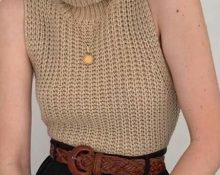
tk.ua
Chambray fabric is of French origin. It first appeared in the distant sixteenth century. Initially, the linen was made from flax. After some time, craftsmen began to use a cotton base. This turned out to be much more practical and profitable. Chambray fabric is an excellent material for making work uniforms. The chambray shirt was considered an essential element of many uniforms.
Matter has both a light and dense structure. This is the name given to cotton fabrics of two colors. They have a plain weave in light and dark colors. In most cases, blue and cyan tints are combined. The color can be called muted; it does not have a rich tone. A chambray shirt or dress looks a little worn, which gives the garment a special charm.
Chambray fabric - what is it?
Chambray is a working, strong fabric of a faded shade. The reason for such an original tone is the poor adhesion of the paint.Mostly, things of muted, natural colors are sewn from fabric. These are pastel, brown, gray, blue and light blue products. The material is of natural origin and is made almost one hundred percent from cotton. A characteristic feature of the fabric is its resemblance to jeans. This is explained by the following features:
- the transverse threads are relatively loose, predominantly white;
- The main thread is dense and has a pronounced color.
To give it a greater resemblance to denim material, craftsmen use a contrasting thread to stitch the edges and seams of the products. The fabric is uniform on all sides, there is no back or front part.
Chambray - what is it, pros and cons
A large number of advantages of the material are provided by the fact that it was originally intended for sewing uniforms. That's why:
- The products can be washed in a washing machine, they do not deform or shrink.
- Small stains are practically invisible on the fabric.
- It rarely shows bruises.
- Clothes do not cause irritation or allergic reactions.
- The structure of the fabric is not hot, despite the relative density.
- The material is highly breathable.
- It absorbs moisture.
- Wear-resistant, static.
Lightweight material has certain disadvantages. Things made from it do not stretch, washing often leads to shrinkage, and clothes take a very long time to dry. In addition, products often lose color and are washed out over a certain period of time.
Chambray fabric - what kind of material is it, where is it used?
The textile industry actively uses fabric in various fields of activity:
- the key direction is sewing chambray shirts - men's and women's shirts;
- production of draperies, covers, bed linen;
- creation of bags, jewelry, appliqués;
- production of sundresses, dresses, shorts, skirts.
The scope of application of the material is very wide. It has long ceased to be used only for sewing work clothes. Many famous designers use chambray in their works.
Chambray fabric - care rules

tk.ua
It is easy to care for the material. You need to wash things in water whose temperature is no more than forty degrees. Any natural material can shrink after washing in hotter water. In addition, hot water often leads to loss of softness of products. They become hard and unpleasant to the body. Other rules of care:
- You can wash with liquid detergents, washing powder, gels.
- It is not recommended to use bleaches to prevent the item from fading.
- Hand and automatic washing is allowed.
- You can wring out the fabric at the maximum setting. When squeezing by hand, do not twist the product excessively. Wet cotton fibers are quite fragile.
- A hot iron is used for ironing. Wet gauze will help smooth out deep folds and creases. It should be placed on the item, then ironed.
- Chambray dries in the same way as all standard fabrics. Some products can be hung on hangers or a special drying rack.
- It is not advisable to dry clothes near heating devices or in the open sun.
- You can dry your clothes in the washing machine, but ironing will take longer.
Sharmus fabric - what is it?
Sharmus is a thin, white, polyester material. It has less density than satin, but is visually similar. Glossy, silky, tactilely pleasant. Often the fabric is used for printing. It turns out colorful, bright, shiny.
The reverse side of the canvas is matte, the outer side is shiny.Sharmus is not afraid of negative atmospheric influences and rarely shrinks during heat treatment.
The canvas is used to create luxurious scarves, shawls, and decorative details.


 0
0





